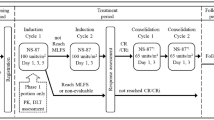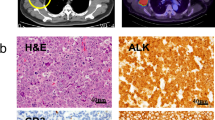Summary
N-Benzyladriamycin-14-valerate (AD 198) is a new lipophilic adriamycin (ADR) analogue that shows marked therapeutic superiority to ADR in murine tumor model systems yet differs mechanistically from ADR in a number of ways. Among its other properties, AD 198 produces a delayed but profound effect on cell-cycle progression and a pattern of continuing DNA damage in cultured cells briefly exposed to the drug. Using radiolabeled drug forms and radioassays combined with HPLC separation and fluorimetric detection techniques, aspects of drug accumulation, biotransformation, and retention in cultured human CEM leukemic lymphocytes were studied, in part to determine a possible pharmacologic basis for the latent effects seen with this drug. In addition, the cellular pharmacology of AD 198 and ADR were comparatively examined under identical experimental conditions. When CEM cells were incubated with drug at equi-growth inhibitory/minimally cytotoxic concentrations (AD 198, 1.0 μM; ADR, 0.1 μM), a number of differences were apparent. Under conditions of continuous 24-h drug exposure, a slow cellular accumulation and equilibration was observed with ADR (cell: medium equilibrium, 1:11 after 4–6 h), whereas the uptake of AD 198 was rapid and extensive (cell: medium equilibrium, 3:1 within 30 min). In drug-retention studies, when cells were pretreated at the same drug concentrations as before (AD 198 for 1 h; ADR for 4 h) and then transferred to drug-free media, both compounds re-equilibrated their intracellular drug content with the fresh media, losing about 50% of their respective anthracycline levels. Liquid chromatographic analysis of ADR-treated cultures under both sets of conditions showed the parent drug to be the only intracellular anthracycline species, whereas analysis of AD 198-treated cultures revealed two fluorescent signals corresponding to the parent drug and its 14-deesterified biotransformation product,N-benzyladriamycin (AD 288). Levels of AD 288 rose from 2% of the total intracellular anthracycline content immediately on drug admixture to 61% following 24 h continuous drug exposure and to 69% at 24 h in cells exposed to drug for 1 h and then continued in drug-free media for 24 h. At all times, the balance of the intracellular anthracycline fluorescence was attributable to the parent drug; no ADR was detectable in AD 198-treated cells by either fluorescence detection or radioassay. Thus, AD 198 is not a prodrug form of ADR, and the in vitro effects of this agent, including the latent effects on cell-cycle inhibition and DNA damage seen in cells following short-term drug exposure, can be explained on the basis of the high levels of active parent drug and biotransformation product that accumulate and persist in the cells.
Similar content being viewed by others
Abbreviations
- ADR:
-
adriamycin (doxorubicin)
- AD 198:
-
N-benzyladriamycin-14-valerate
- AD 288:
-
N-benzyladriamycin
- AD 32:
-
N-trifluoroacetyladriamycin-14-valerate
- AD 143:
-
N-trifluoroacetyladriamycin-14-0-hemiadipate
- AD 41:
-
N-trifluoroacetyladriamycin
- [14C]-AD 198:
-
[benzyl]-α-methylene-14C]-N-benzyladriamycin-14-valerate
- [14C]-ADR:
-
[14-14C]-adriamycin
- HPLC:
-
high-performance liquid chromatography
- TLC:
-
thin-layer chromatography
- DMSO:
-
dimethylsulfoxide
- S-MEM:
-
Eagle's minimum essential medium for suspension culture
- PBS:
-
phosphate-buffered saline (pH 7.0)
References
Bodley A, Liu LF, Israel M, Seshadri R, Koseki Y, Giuliani FC, Silber R, Kirschenbaum S, Potmesil M (1989) DNA topoisomerase II-mediated interaction by doxorubicin and daunorubicin congeners with DNA. Cancer Res (in press)
Bodley A, Liu LF, Israel M, Seshadri R, Koseki Y, Kirschenbaum S, Silber R, Potmesil M (1989)N-Alkyl analogs of doxorubicin do not inhibit DNA topoisomerase II. Proc Am Assoc Cancer Res 30: 621
DiMarco A (1975) Adriamycin (NSC-123127): mode and mechanism of action. Cancer Chemother Rep 6 [3]: 91
DiMarco A (1982) Anthracycline antibiotics. In: Holland JF, Frei E III (eds) Cancer medicine, 2nd edn. Lea and Febiger, Philadelphia, p 872
Ganapathi R, Grabowski D, Sweatman TW, Seshadri R, Israel M (1988) Characterization in vitro and in vivo of cross-resistance toN-benzyladriamycin-14-valerate in progressively doxorubicin-resistant cells. Proc Am Assoc Cancer Res 29: 299
Israel M, Modest EJ (1977)N-Trifluoroacetyladriamycin-14-alkanoates and therapeutic compositions containing same. U.S. Patent 4,035,566. U.S. Patent Office, Washington, DC
Israel M, Seshadri R (1986)N-Alkyl andN-benzyl adriamycin derivatives. U.S. Patent 4,610,977. U.S. Patent Office, Washington, DC
Israel M, Seshadri R, Idriss JM (1985)N-Benzyladriamycin-14-valerate (AD 198), a promising new adriamycin (ADR) analog. Proc Am Assoc Cancer Res 26: 224
Israel M, Idriss JM, Seshadri R (1986) In vitro studies withN-benzyladriamycin-14-valerate (AD 198), a new anthracycline analog. Abstracts, 14th International Cancer Congress, Budapest, Hungary, August 1986, vol 1. Akademiai Kiado, Budapest, p 159
Israel M, Idriss JM, Koseki Y, Khetarpal VK (1987) Comparative effects of adriamycin and DNA-nonbinding analogues on DNA, RNA, and protein synthesis in vitro. Cancer Chemother Pharmacol 20: 277
Israel M, Seshadri R, Koseki Y, Sweatman TW, Idriss JM (1987) Amelioration of adriamycin toxicity through modification of drug-DNA binding properties. Cancer Treat Rev 14: 163
Krishan A, Israel M, Modest EJ, Frei E III (1976) Differences in cellular uptake and cytofluorescence of adriamycin andN-trifluoroacetyladriamycin-14-valerate. Cancer Res 36: 2114
Krishan A, Israel M, Sauertieg A (1986) Cellular retention and cytotoxicity ofN-benzyladriamycin-14-valerate (AD 198) in doxorubicin-resistant P388/R84 cells. Proc Am Assoc Cancer Res 27: 245
Maniar N, Krishan A, Israel M, Samy TSA (1988) Anthracycline-induced DNA breaks and resealing in doxorubicin-resistant murine leukemia P388 cells. Biochem Pharmacol 37: 1763
Meriwether WD, Bachur NR (1972) Inhibition of DNA and RNA metabolism in L1210 leukemia. Cancer Res 32: 1137
Penco S, Vicario GP, Angelucci F, Arcamone F (1977) Synthesis of [14-14C]-daunorubicin and doxorubicin. J Antibiot 30: 73
Potmesil M, Israel M, Seshadri R, Sweatman TW, Kirschenbaum S, Silber R (1987) Structure and biological activity ofN-substituted anthracyclines: correlation with drug-DNA topoisomerase II interaction. Proc Am Assoc Cancer Res 28: 262
Silber R, Liu LF, Israel M, Bodley AL, Hsiang Y-H, Kirschenbaum S, Sweatman TW, Seshadri R, Potmesil M (1987) Metabolic activation ofN-acylanthracyclines procedes their interaction with DNA topoisomerase II. NCI Monogr 4: 111
Sweatman TW, Koseki Y, Seshadri R, Israel M, Beck WT (1988) Activity ofN-benzyladriamycin-14-valerate (AD 198) in vitro against mechanistically different multidrug-resistant CEM cell lines. Proc Am Assoc Cancer Res 29: 271
Tewey KM, Rowe TC, Yang L, Halligan BD, Liu LF (1983) Adriamycin-induced DNA damage mediated by mammalian DNA topoisomerase II. Science 226: 466
Traganos F, Israel M, Seshadri R, Kirschenbaum S, Potmesil M (1985) Effects of newN-alkyl analogues of adriamycin on in vitro survival and cell-cycle progression of L1210 cells. Cancer Res 45: 6272
Author information
Authors and Affiliations
Rights and permissions
About this article
Cite this article
Israel, M., Sweatman, T.W., Seshadri, R. et al. Comparative uptake and retention of adriamycin andN-benzyladriamycin-14-valerate in human CEM leukemic lymphocyte cell cultures. Cancer Chemother. Pharmacol. 25, 177–183 (1989). https://doi.org/10.1007/BF00689579
Received:
Accepted:
Issue Date:
DOI: https://doi.org/10.1007/BF00689579




